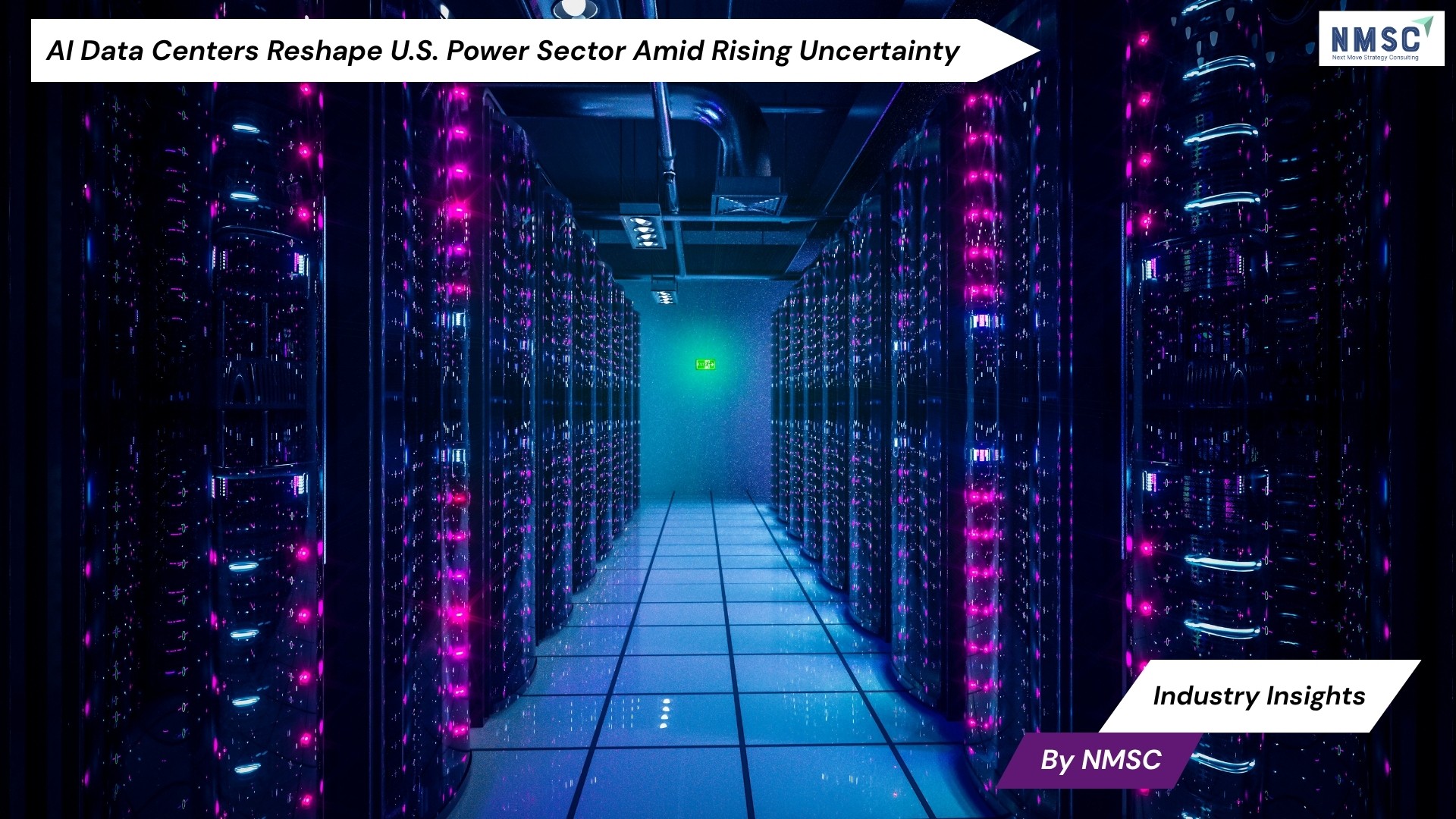AI Data Centers Disrupt U.S. Power Sector Amid Uncertainty
Published: 2025-10-18

Industry Insights from Next Move Strategy Consulting
As artificial intelligence transforms digital infrastructure, the rapid rise of AI-driven data centers is creating both unprecedented opportunity and deep uncertainty within the U.S. energy sector. Power utilities, regulators, and technology firms now face a fundamental question: how much of the projected AI-related electricity demand will truly materialize — and how much is speculative momentum?
A Wave of Mega-Projects and Mounting Pressure
AI companies are announcing billion-dollar data center projects at a historic pace, fueling a powerful rally in the utility sector. However, the utilities responsible for delivering the electricity needed to power this transformation are struggling to determine which projects will actually be built in their regions.
“There is a question about whether or not all of the projections, if they’re real,” said Willie Phillips, former chairman of the Federal Energy Regulatory Commission (FERC). Some regions that initially projected huge increases in power demand have since scaled those expectations back.
The challenge is compounded by “data center shopping,” where technology companies present identical projects to multiple utilities as they seek faster access to electricity. According to GridUnity CEO Brian Fitzsimons, this practice makes it increasingly difficult for utilities to gauge real demand and plan accordingly.
The Billion-Dollar Balancing Act
The stakes are immense. As FERC Chairman David Rosner cautioned, even a small error in electricity load forecasts can translate into billions of dollars in investment swings and significant shifts in customer electricity bills.
Constellation Energy CEO Joe Dominguez echoed this concern, warning that current projections may be overstated: “We need to pump the brakes here.”
Yet the stock market shows little hesitation. The utility sector has gained about 21% this year after a 19% rally in 2024 — adding nearly $500 billion in market value over two years, its strongest performance since the early 2000s.
The Question of an AI Bubble
Despite widespread optimism, concerns of an AI-driven investment bubble are growing. OpenAI CEO Sam Altman recently warned investors about overexcitement in AI markets. Still, experts like Rob Gramlich, President of Grid Strategies, maintain that the demand from existing and planned data centers reflects a tangible and transformative shift in U.S. energy consumption.
Gramlich noted that today’s data centers can reach gigawatt-scale operations — twenty times the size of what was once considered large. Grid Strategies projects 120 gigawatts of new electricity demand by 2030, including 60 gigawatts from data centers alone — equivalent to Italy’s 2024 peak hourly demand.
“This is not a bubble,” Fitzsimons emphasized. “It’s going to transform our nation completely. We need a 50-year energy policy.”
Infrastructure Constraints and Energy Pathways
OpenAI’s recent partnership with Nvidia — a plan to build 10 gigawatts of data centers — underscores both the potential and the challenges ahead. The project’s electricity requirement rivals that of New York City on its hottest summer days, highlighting the strain on current infrastructure.
Experts warn that the U.S. lacks the generation and transmission capacity needed to meet aggressive AI expansion goals. Natural gas turbine availability is constrained through the end of the decade, while advanced nuclear technologies remain years away from commercial deployment.
Renewable energy — particularly solar and battery storage — offers the fastest deployment path, with more than 90% of queued power projects in these categories. However, political uncertainty under President Donald Trump’s administration, which favors coal, natural gas, and nuclear power over renewables, may complicate the path forward.
Reinventing the Power Equation
In response to infrastructure limitations, some AI companies are pursuing “behind-the-meter” solutions — building their own power generation directly at data center sites to bypass grid constraints. Nvidia CEO Jensen Huang supports this approach: “Data center self-generated power could move a lot faster than putting it on the grid — and we have to do that.”
Still, utilities warn that grid reliability remains their core mandate. “If they literally do not have the power to serve a customer, they’re not going to sacrifice reliability,” said Gramlich.
The Edison Electric Institute reports that utilities spent $178 billion on grid upgrades last year and expect $1.1 trillion in capital investments through 2029. Despite these figures, supply chain constraints and inflation continue to slow progress, forcing utilities to plan more cautiously than in past expansion cycles.
Next Move Strategy Consulting View
According to Next Move Strategy Consulting, the AI data center surge represents a pivotal inflection point for the energy and infrastructure sectors. The convergence of artificial intelligence, renewable energy, and decentralized power generation is redefining long-term planning across the utility landscape.
Analysts emphasize that success will depend on three strategic imperatives: forecast accuracy, infrastructure agility, and energy diversification. Utilities must strengthen predictive modeling to distinguish genuine demand from speculative projections, while policymakers and investors must coordinate to fast-track grid modernization and renewable integration.
The consulting firm highlights that behind-the-meter generation could emerge as a major growth segment, enabling faster deployment and reducing dependence on centralized grid systems. However, without coordinated planning, uneven growth could exacerbate grid imbalances and investment inefficiencies.
Ultimately, the intersection of AI and energy infrastructure demands a new paradigm — one where digital innovation, sustainable energy policy, and responsible capital allocation advance together to ensure long-term reliability and growth.
A Turning Point for the Data Center Market
The AI-driven data center revolution has already reshaped technology and investment priorities. What remains uncertain is whether utilities, regulators, and energy suppliers can build — literally and strategically — fast enough to sustain it.
As billions of dollars flow into projects, the race to balance innovation with infrastructure capacity will define the next chapter of America’s digital and energy evolution.
Source: CNBC
Prepared by: Next Move Strategy Consulting
About the Author
 Tania Dey is an experienced Content Writer specializing in digital transformation and market insights. She creates data-driven content that boosts visibility and aligns with emerging trends. Known for simplifying complexity, she delivers engaging narratives that help organizations stay competitive
Tania Dey is an experienced Content Writer specializing in digital transformation and market insights. She creates data-driven content that boosts visibility and aligns with emerging trends. Known for simplifying complexity, she delivers engaging narratives that help organizations stay competitive
About the Reviewer
 Sanyukta Deb is a skilled Content Writer and Digital Marketing Team Leader, specializing in online visibility strategies and data-driven campaigns. She excels at creating audience-focused content that boosts brand presence and engagement, while also pursuing creative projects and design interests
Sanyukta Deb is a skilled Content Writer and Digital Marketing Team Leader, specializing in online visibility strategies and data-driven campaigns. She excels at creating audience-focused content that boosts brand presence and engagement, while also pursuing creative projects and design interests
















Add Comment